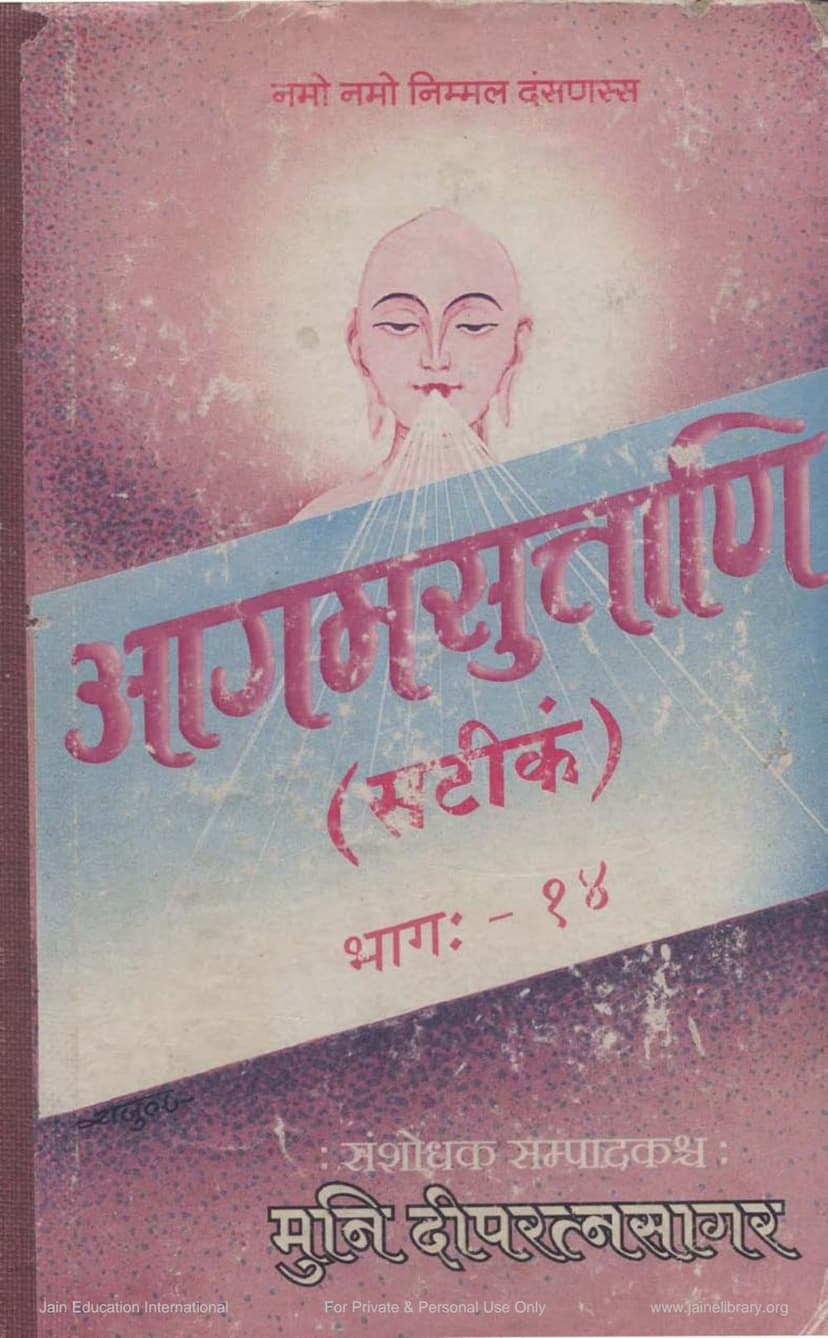Agam Sutra Satik 33 Maransamadhi PainngSutra 10
Added to library: September 1, 2025

Summary
This Jain text, titled "Agam Sutra Satik 33 Maransamadhi PainngSutra 10," is part of a larger series called "Agam Suvani" (भाग: - १४), with the specific volume covering Agama Sutras from 19 to 33. The author and editor is Muni Deepratnasagar. Published by Agam Shrut Prakashan, this work is a commentary (Satik) on various Jain scriptures, including five Upanga Sutras and ten Prakirna Sutras.
The text is a comprehensive compilation of significant Jain scriptural texts, including:
Upanga Sutras (covering Agamas 19-23):
- Nirayavalika Upanga Sutra
- Kalpavatasika Upanga Sutra
- Pushpika Upanga Sutra
- Pushpchulika Upanga Sutra
- Vrushni Dasha Upanga Sutra
Prakirna Sutras (ten in number, covering Agamas 24-33):
- Chatuhsharana Prakirnaka Sutra
- Atura Pratyakhyana Prakirnaka Sutra
- Mahapratyakhyana Prakirnaka Sutra
- Bhakta Parignya Prakirnaka Sutra
- Tandula Vaicharika Prakirnaka Sutra
- Samstaraka Prakirnaka Sutra
- Gachchachara Prakirnaka Sutra
- Ganividya Prakirnaka Sutra
- Devendra Stava Prakirnaka Sutra
- Maransamadhi Prakirnaka Sutra (This is the focal point, indicated by the title and emphasis on pages 8 and onwards).
Key Themes and Content:
The "Maransamadhi Prakirnaka Sutra" (Chapter 33) is the central focus of this volume. It deals with the science and philosophy of a peaceful and prepared death (Maransamadhi), aligning with the Jain principles of right faith, knowledge, and conduct. The text elaborates on:
- The nature of death and the afterlife: Discusses the importance of preparing for the final moments of life.
- Practices for achieving peaceful death: Details various methods and contemplative practices that lead to a state of equanimity at the time of death. This includes adherence to vows, practices of meditation, and cultivating virtues.
- The significance of the Soul's journey: Emphasizes the soul's liberation (moksha) and the importance of overcoming worldly attachments and negative karma.
- The role of penance and self-purification: Highlights the necessity of austerity (tapas) and other spiritual practices for purifying the soul and achieving a favorable rebirth or liberation.
- The teachings of Tirthankaras: The text references the guidance provided by the Tirthankaras on achieving a state of spiritual readiness for death.
- The concept of Pandit Maran (wise death): Contrasts it with ignorant or accidental death, emphasizing the conscious, virtuous, and knowledge-filled passing of a soul.
- The importance of introspection and repentance: Encourages reflecting on one's actions, seeking forgiveness, and purifying the mind and body.
- The "Twelve Bhavanas" (meditations): These are likely discussed as crucial tools for mental preparation and achieving equanimity.
- Various examples and stories: The text likely includes narratives of accomplished souls who achieved Maransamadhi to illustrate the principles.
Structure and Presentation:
The book is presented in a scholarly manner, with the original Sanskrit text, its translation, and potentially commentary or explanations. The detailed table of contents on pages 3-6 provides a breakdown of the subjects covered within each of the included sutras, indicating the specific chapters and themes within them. Page 8 onwards shows the transliteration and Sanskrit commentary of the Maransamadhi Prakirnaka Sutra itself, demonstrating the depth of its coverage. The publisher's notes and dedications on subsequent pages indicate the collaborative effort and support behind this publication.
In essence, this work is a profound guide within Jainism for understanding and practicing the art of dying well, emphasizing spiritual preparedness, detachment, and the ultimate pursuit of liberation.